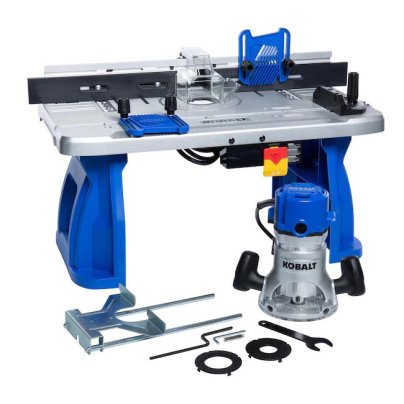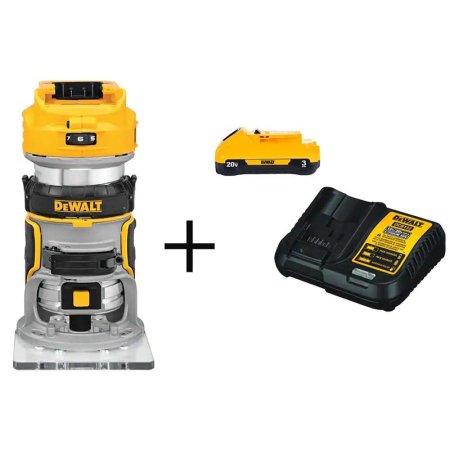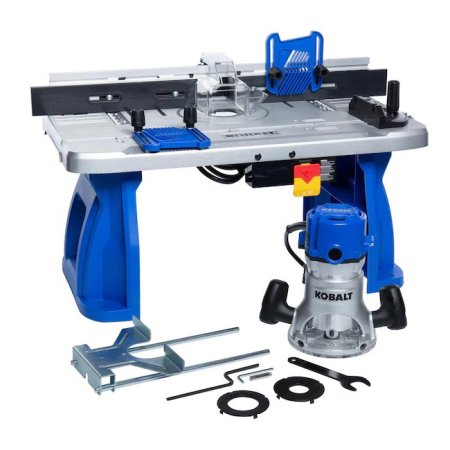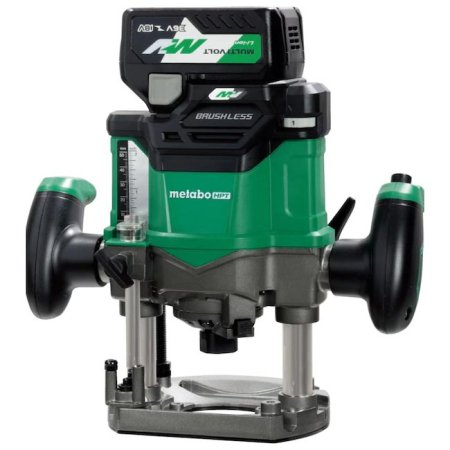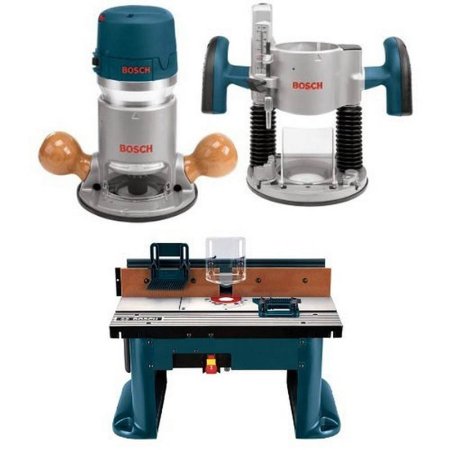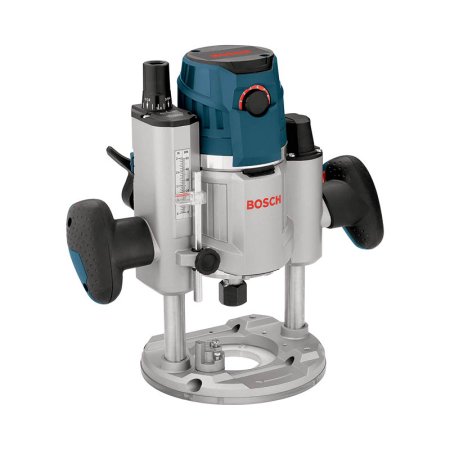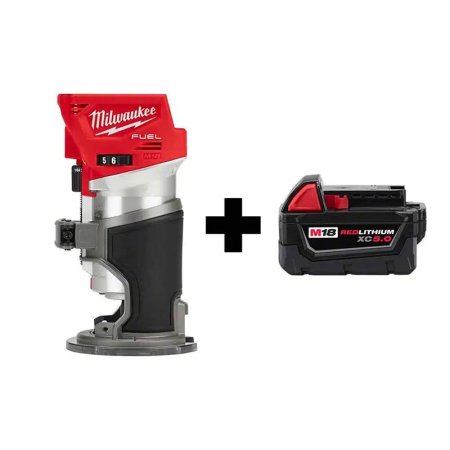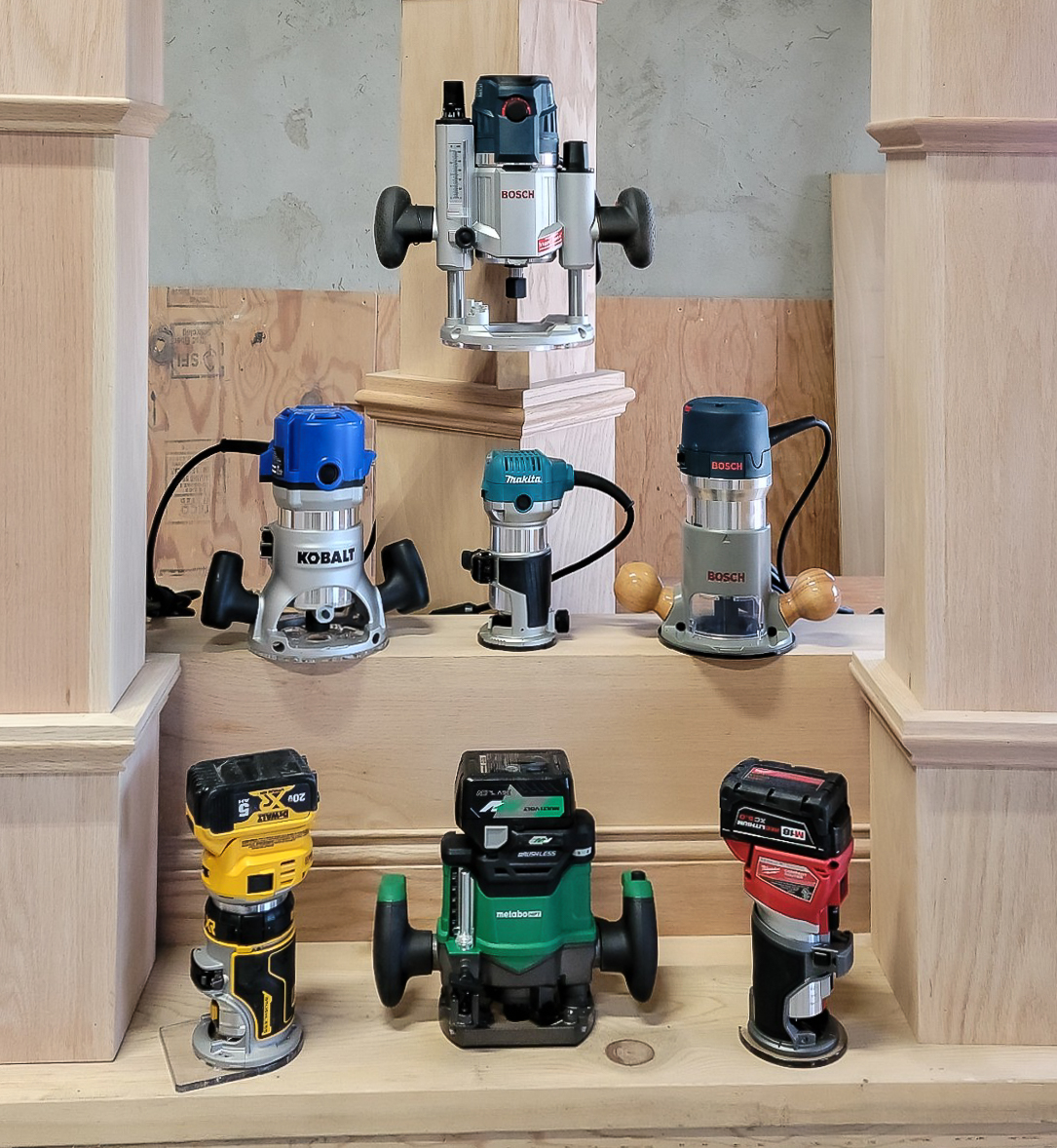
We may earn revenue from the products available on this page and participate in affiliate programs. Learn More ›

Our Favorite Wood Routers On Sale Now!
Our Best Bang pick, the Kobalt Corded Router and Router Table, is on sale for just $149 (Save $30) at Lowe’s. This versatile kit even includes a router table for stationary use and its power 12-amp motor cuts through all kinds of wood.
If you’re looking cordless convenience, check out our Best Cordless option, the Metabo HPT 36V Cordless Variable Speed Plunge Router, for $271.48 (Save $147.52) at Amazon. Not only does it have a powerful motor, but the Metabo comes with dual ergonomic handles and features a power button right on the top of one handle, making it simple to start and stop.
Hurry! These deals won’t last long!
Seasoned DIYers and hobbyists know the difference a wood router can make on the quality of a woodworking project. From simple round-overs to fancy ogee (S-shaped) edges, the best wood router adds finishing touches that give the project a professional look. Routers are straightforward tools that use a spinning bit to shape the edges of boards or make cutouts for wood joints or decorative elements.
Power tool manufacturers have made several advances in their routers in recent years, adding variable-speed dials, ergonomic handles, and plunge capability, so we wanted to test the top models to see how they performed. We also reached out to a professional woodworker to get expert insight into what to look for in a router. We selected from today’s best-selling options and tried them out in our woodworking shop to determine where they excelled—and what they could do better. We tested every function and scored the routers based on their performance.
Our favorite is the DeWalt 20V Max XR Brushless Cordless Compact Router for its power and precision, as well as helpful additional features like soft-start technology and dual LED lights. But there are plenty more great options here. Ahead, learn what to look for when selecting the best wood router for your project needs, and find out how the following models earned a spot in our lineup.
- BEST OVERALL: DeWalt 20V Max XR Brushless Cordless Compact Router
- BEST BANG FOR THE BUCK: Kobalt Corded Router and Router Table
- BEST CORDLESS: Metabo HPT 36V Cordless Variable Speed Plunge Router
- BEST KIT: Bosch 1617EVSPK Plunge- and Fixed-Base Router Kit
- BEST PALM ROUTER: Makita RT0701C 1-1¼ HP Compact Router
- BEST PLUNGE ROUTER: Bosch MRP23EVS 2.3 HP Electronic Plunge-Base Router
- BEST TRIM ROUTER: Milwaukee M18 Fuel Compact Router
| Type | Speed | Collet Size | Weight | |
| DeWalt 20V Max XR Cordless Compact Router Kit—$366.26 | Fixed base | Up to 25,000 rpm | ¼ inch | 4.1 pounds (without battery) |
| Kobalt Corded Router and Router Table—$149 | Fixed base | Up to 25,000 rpm | ¼ inch and ½ inch | 19.18 pounds |
| Metabo HPT 36V Cordless Variable Speed Plunge Router—$271.48 | Plunge | Up to 25,000 rpm | ¼ inch and ½ inch | 6.9 pounds (without battery) |
| Bosch 1617EVSPK Plunge- and Fixed-Base Router Kit—$401.43 | Combo | Up to 25,000 rpm | ¼ inch, ⅜ inch, ½ inch, and 8 mm | 10 pounds |
| Makita RT0701C 1-1¼ HP Compact Router—$149 | Fixed base | Up to 30,000 rpm | ¼ inch | 3.9 pounds |
| Bosch MRP23EVS 2.3 HP Electronic Plunge-Base Router—$279 | Plunge | Up to 25,000 rpm | ¼ inch and ½ inch | 12.6 pounds |
| Milwaukee M18 Fuel Compact Router With Battery—$358 | Fixed base | Up to 31,000 rpm | ¼ inch | 2.95 pounds (without battery) |
Our Top Picks
The following routers performed well in our hands-on tests and earned their place in this lineup. We tested routers for a range of needs, including basic models for general edge shaping, plunge-cut picks for cutting in the center of the wood, and even a couple that come with tables for more stability. Whether shoppers are looking for a corded shop model or a battery-operated portable router, they’re sure to find a good performer here.
Best Overall
DeWalt 20V Max XR Brushless Cordless Compact Router
Product Specs
- Type: Fixed base
- Speed: Up to 25,500 revolutions per minute (rpm)
- Collet size: ¼ inch
- Weight: 4.1 pounds (without battery)
This Bob Vila Approved product carries our brand’s highest level of recommendation.

Bob Vila Approved recognizes the household and DIY products that impressed us most in our real-world testing and that exemplify core values of the Bob Vila brand, including craftsmanship, innovation, and value for the dollar. Winners of this designation come recommended by our professional review team and are personally approved by Bob Vila.
What We Like
- Soft-start technology allows the bit to speed up gradually
- Compact enough for 1-handed operation
- Variable-speed dial is easy to reach
- Dual LED lights help to illuminate the work area
What We Don’t Like
- Best suited to small projects and detailed work
We didn’t set out to choose a compact model for our Best Overall pick, but the DeWalt 20V Max XR Brushless Cordless Compact Router is only small when it comes to size—it’s right up there with full-size models when it comes to power and precision.
We’re familiar with DeWalt’s pro-quality power tools, so we weren’t surprised by the top-notch performance of this cordless route. It comes with a 20V MAX 3 amp hour (Ah) lithium-ion battery that powers the motor to speeds up to 25,500 rpm. A dial at the top of the motor adjusts the speed, and we found it simple to reach with a thumb without shifting our grip on the tool itself. The DeWalt can be held with two hands, but it’s compact enough to operate using just one—for those situations where a board must be braced with the other hand while routing.
We liked its soft-start technology that started the bit spinning smoothly without jerking the tool. It also uses constant response to monitor the bit’s speed and adjust it to suit the density of the wood. We routed the edges of both pine boards and hardwood (oak) boards and got smooth edge profiles on both. We also tested the DeWalt in the center of our material; this required tipping the tool, but its clear base gave us added visibility, so the results were good.
The DeWalt router comes with the ability to make micro adjustments to the bit’s depth, which is vital for precision designs. This fine-tuning ability separates an average router from a great one. The tool also features a guiding light that was bright enough to illuminate clearly the material we were routing. The only downside—and it’s just a personal choice—is not having a ½-inch collet. The collet on this DeWalt router is only ¼ inch, so it’s well suited to routing curves and details on smaller projects rather than commercial use.
What our tester says: “I found the DeWalt compact router capable of creating edge designs and profiles as smooth and precise as larger routers. Not only is this router comfortable to use, but at less than 4 pounds, I found I could use it continuously for more than an hour—without suffering from hand or wrist fatigue.” —Glenda Taylor, Product Reviews tester and writer
Read our full review: DeWalt 20V Max XR Brushless Cordless Compact Router
Get the DeWalt wood router at The Home Depot (battery and charger included), Amazon, Lowe’s, or Ace Hardware.
Best Bang for the Buck
Kobalt Corded Router and Router Table
Product Specs
- Type: Fixed base
- Speed: Up to 25,000 rpm
- Collet size: ¼ inch and ½ inch
- Weight: 19.18 pounds
What We Like
- 12-amp motor easily cuts through hardwood
- Includes router table for stationary operation
- The router has both ¼-inch and ½-inch collets
What We Don’t Like
- Speed is not adjustable
This Kobalt router can tackle a range of jobs without costing a fortune. It has a 12-amp motor and spins up to 25,000 rpm, depending on wood density, although the speed is not adjustable. The fixed-base router housing features two ergonomic handles that gave us a high degree of stability while we worked freehand. Still, we liked the ability to connect it to the router table (included), which gave us added control.
When attached to the table, the power is controlled via a large red/yellow button on the front—no reaching under the table and fumbling for a switch on the router itself. This is a nice feature, and the instructions for setting it up come with the table assembly manual. We assembled the table in about 10 minutes.
We routed the edges on both soft pine and harder oak, and the corded Kobalt performed flawlessly both when we used it freehand and attached to the router table. We had trouble starting cuts in the center of our material, mainly because the router base blocked the visibility of the bit when we tipped the router in place. (Tipping is required when starting a fixed-base router in the center of the material.)
For some, the lack of adjustable speed may be a slight downside, but with practice and a light touch, we found we could adjust the pressure of the bit against the wood and still maintain a high level of control.
Get the Kobalt wood router at Lowe’s.
Best Cordless
Metabo HTP 36V Cordless Variable Speed Plunge Router
Product Specs
- Type: Plunge
- Speed: Up to 25,000 rpm
- Collet size: ¼ inch and ½ inch
- Weight: 6.9 pounds (without battery)
What We Like
- Powerful 36-volt (V) motor
- Dual handles are ergonomic
- Cordless portability and versatility
- Plunge action allows for precision routing
What We Don’t Like
- Guide light is dim
Here come the power players! The 36-volt motor on the Metabo plunge router is powerful enough to generate up to 25,000 rpm of spinning-bit speed—as much as many full-size corded models. It also features a speed adjustment that let us reduce the speed as desired during testing.
This is a plunge router, so we used it to start routing in the centers of our boards. The open center base plate design allowed us to see and align the bit precisely before we started routing. The Metabo comes with dual ergonomic handles and features a power button right on the top of one handle, making it simple to start and stop. It comes with bit depth adjustment and runs on a rechargeable lithium-ion battery (included).
The plunge action is smooth, and we found it easy to lower the spinning bit into the wood and then cut detailed designs. We also tested the Metabo’s performance making outside edge cuts: While we were able to create several uniform edge profiles, we had the best results with plunge routing.
The Metabo cut smoothly on both pine and oak boards. If we could change one thing, we’d opt for a brighter LED guide light, since clearly seeing the material while routing is one of the keys to professional-looking designs.
Get the Metabo wood router at Amazon, Lowe’s, or Acme Tools.
Best Kit
Bosch 1617EVSPK Plunge- and Fixed-Base Router Kit
Product Specs
- Type: Combo
- Speed: Up to 25,000 rpm
- Collet size: ¼ inch, ⅜ inch, ½ inch, and 8 millimeters
- Weight: 10 pounds
What We Like
- Includes plunge base, fixed base, and benchtop functionality
- Powerful 12-amp motor
- Motor automatically adjusts to maintain consistent bit speed
What We Don’t Like
- Setup takes a while and is not straightforward
The Bosch Router Power Tools kit has almost endless possibilities. This router set comes with a plunge base, a fixed base, and a benchtop table, all compatible with the included router. The router itself features a 12-amp motor with speed adjustments up to 25,000 rpm.
Swapping from the fixed-base casing to the plunge casing was straightforward, taking about 3 minutes per change, and both bases come with precision bit depth adjustments. We used the plunge base to test cuts in the field and found it easy to align the bit and lower the router effortlessly for accurate cuts.
With the fixed-base casing on, we tested the Bosch router for freehand cuts and table cuts. It worked flawlessly on both—the routed designs were smooth and precise. The table is sturdy and stable, but it did take about 30 minutes to assemble. Once assembled, however, it took only a few minutes to attach the router to the underside of the table. The constant-speed feature directed more power to the bit when we switched from pine to oak. We could hear the motor increase in horsepower to keep the bit spinning at our selected speed.
This kit is on the pricey side, but it’s a top option for woodworkers who work on various projects and need both a plunge router and a fixed-base router.
Get the Bosch 1617EVSPK wood router at Amazon or The Home Depot.
Best Palm Router
Makita RT0701C 1-1¼ HP Compact Router
Product Specs
- Type: Fixed base
- Speed: Up to 30,000 rpm
- Collet size: ¼ inch
- Weight: 3.9 pounds
What We Like
- The lightweight and portable design
- Slow-start technology keeps the router from jumping
- Maintains stability on startup despite its light weight
What We Don’t Like
- Limited visibility with the fixed base
- Does not include a ½-inch collet
We’re fans of the high-quality Makita power tools, and this compact router didn’t disappoint. We tested this router with a fixed base, but buyers can choose a kit with an interchangeable plunge base if desired.
Some lightweight palm routers tend to jump on start-up since they’re not heavy enough to offer much stability. This wasn’t an issue for the Makita router, which weighs 3.9 pounds thanks to its slow-start technology for safe and easily controlled start-ups. (These features also make it a great wood router for beginners.) The base slides off the motor easily for bit changes—an essential feature for palm routers with small bases to make it easier to change bits.
The compact Makita’s 6.5-amp motor adjusts for speeds up to 30,000 rpm via a dial on top of the tool. At the top end, that’s among the fastest rotation speed of the routers we tested, but keep in mind that this router is designed chiefly for workshop-type use—it’s not made for heavy-duty routing of a commercial nature. We tried it on both pine and oak, but we noticed a slight slowing of the bit on the oak. There’s a simple solution for this, however: Just ease up on the pressure and plan to make an additional two or three passes when routing hardwoods. We were able to get detailed designs using that methodology.
The only notable downside was using the Makita to start cuts in the field. The base plate is not designed for easily viewing the wood, but that’s why Makita offers a plunge base that can be purchased separately. This little router comes with a ¼-inch collet.
Get the Makita wood router at Amazon or Rockler (plunge base included).
Best Plunge Router
Bosch MRP23EVS 2.3 HP Electronic Plunge-Base Router
Product Specs
- Type: Plunge
- Speed: Up to 25,000 rpm
- Collet size: ¼ inch and ½ inch
- Weight: 12.6 pounds
What We Like
- Powerful 15-amp motor routes dense wood
- Handle-mounted trigger
- Soft-start technology
- Bright guide light
What We Don’t Like
- Speed adjustment dial is on top of the router
The first thing we noticed when unboxing the Bosch 2.3 horsepower (hp) plunge router was how heavy it was. That 12.6 pounds indicated that it would have high stability during operation. We also found the extra weight to reduce vibration.
The router has a 15-amp motor with an adjustable speed range of up to 25,000 rpm, and it features constant response, so the motor kicked in more power when we switched to dense hardwood. The speed dial is located on the top of the router, which is a little unhandy because we had to release one of the handles to adjust it. It would have been nice having it closer to the handles where it could be adjusted via a thumb without releasing our grip on the tool.
The power trigger is on the handle, which makes it easy to start and stop the bit while keeping a firm grasp. Also, this plunge-base router features soft-start technology, and we appreciated being able to start the bit without the router jerking, which is an issue with some routers.
One of our favorite features on this plunge router was the precision bit depth adjustment that allowed microfine depth tuning and an easy-to-see depth gauge. In addition to routing precisely in the center of the field, we tested the Bosch on edge routing, and the open-base design, plus the bright guide light, made it possible to control the tool and achieve smooth, uniform results.
Get the Bosch MRP23EVS wood router at Amazon, Lowe’s, or The Home Depot.
Best Trim Router
Milwaukee M18 Fuel Compact Router
Product Specs
- Type: Fixed base
- Speed: Up to 31,000 rpm
- Collet size: ¼ inch
- Weight: 2.95 pounds (without battery)
What We Like
- High rpm makes for smooth routed edges
- Compact enough for 1-handed use
- Precision bit depth adjustment for highly accurate routing
What We Don’t Like
- Ineffective dust port
- Does not come with a battery charger
Compact and cordless, the Milwaukee trim router can be used anywhere—in the woodshop or on the project site because there’s no need to plug it in. Buyers should be aware, however, that the router comes with a rechargeable M18 lithium-ion battery but no battery charger. This won’t be an issue for those with other Milwaukee M18 tools because the battery can be charged in one of those chargers, but anyone who doesn’t have a charger will need to buy one separately.
We tested this fixed-base router on both the edges of the boards and in the field. Like all fixed-base models, we had to tip it to start cuts in the field, but the see-through acrylic ring at the base’s outer edge and the open-base design provided a measure of extra visibility, and we got good results. Plus, it comes with a strong LED guide light.
The depth adjustment is precise and easy to change, but we found the dust collection port to be more trouble than it was worth. Attaching it required disassembling the base and reassembling it with the port in place. We hooked it to our wet/dry-type vacuum, but we didn’t notice that it reduced the dust expelled from the router. It still blew most of the dust out of the bottom of the tool.
This compact Milwaukee offers up to 31,000 rpm and comes with a speed-adjustment dial. The high rpm makes for smooth edges that require minimal sanding. Still, this router is best suited to light-duty work, such as routing the edges of trim boards, because it comes with only a ¼-inch collet for small bits.
Get the Milwaukee wood router at The Home Depot, Milwaukee (tool only), or Walmart.
Jump to Our Top Picks
How We Tested the Best Wood Routers
For this guide, we sought the advice of Richard Louise, a professional woodworker with over 40 years of experience and founder of Dove Tails and Stitches, based in Birmingham, Alabama. A third-generation furniture maker, Louise had plenty to share on how to choose a wood router.
He says that motor power is vital to consider: “However, it is not as clear cut as bigger is better. It really depends on the task you are doing with the router.” He continues, “Using a template bit to trim a 2-inch thick piece of hard maple, yes, a 2 or 2 ½ horsepower router is almost mandatory.” He also adds, “These are relatively large hand tools, so when you are doing something more intricate or delicate, say routing out for a bowtie, then I would opt for a smaller more nimble router, maybe even a trim router.”
We took this expert advice in mind as we analyzed more than 25 routers before choosing which ones we would test. We looked for the best models by type, speed, horsepower, ease of use, and other special features included by select brands. We also noted the collet size of each tool—the collet is the ring that holds the router bit in place. Some routers come with a ¼-inch collet while others come with an additional ½-inch collet. A ½-inch collet is best suited to heavy-duty routing projects, but a ¼-inch collet is suitable for most DIY routing tasks.
We selected both fixed-base routers and plunge routers for our tests. The models we tested came with various power sources and included bit speeds up to 31,000 rpm. We tested compact and full-size models to cover a range of user needs.
Next, we gathered armfuls of pine and oak boards and then started to test, routing the outside edges of the boards. We also tested the routers by beginning our cuts in the center of the material (aka the field), which required either a plunge router or carefully tipping a spinning router down when we were using a fixed-base model. We used various router bits to achieve different design results, and we noted how easy it was to adjust the bit’s depth and how precise the depth adjustment was.
We noted the brightness of the router’s guide lights, if applicable, the comfort factor (i.e., ergonomics), and how well the motor held up to routing dense wood, such as oak. As we put the routers through their paces, we awarded points for each based on a rubric. The better a router did on a specific test, the higher the points it received. After testing, we added and averaged the points to help determine the most suitable category for each model.
| Testing Stats | |
|---|---|
| Products tested | 7 |
| Time spent testing | 12 hours |
| Tests performed | 5 |
| Price range | $150 to $400 |
What to Consider When Choosing a Wood Router
Beyond the different styles of routers, shoppers will want to keep in mind some additional considerations—specs, overall power, and special features—when looking for the best wood router for their needs. Some of these points might matter more than others, so they ought to keep the intended projects in mind when choosing a router.
Types of Wood Routers
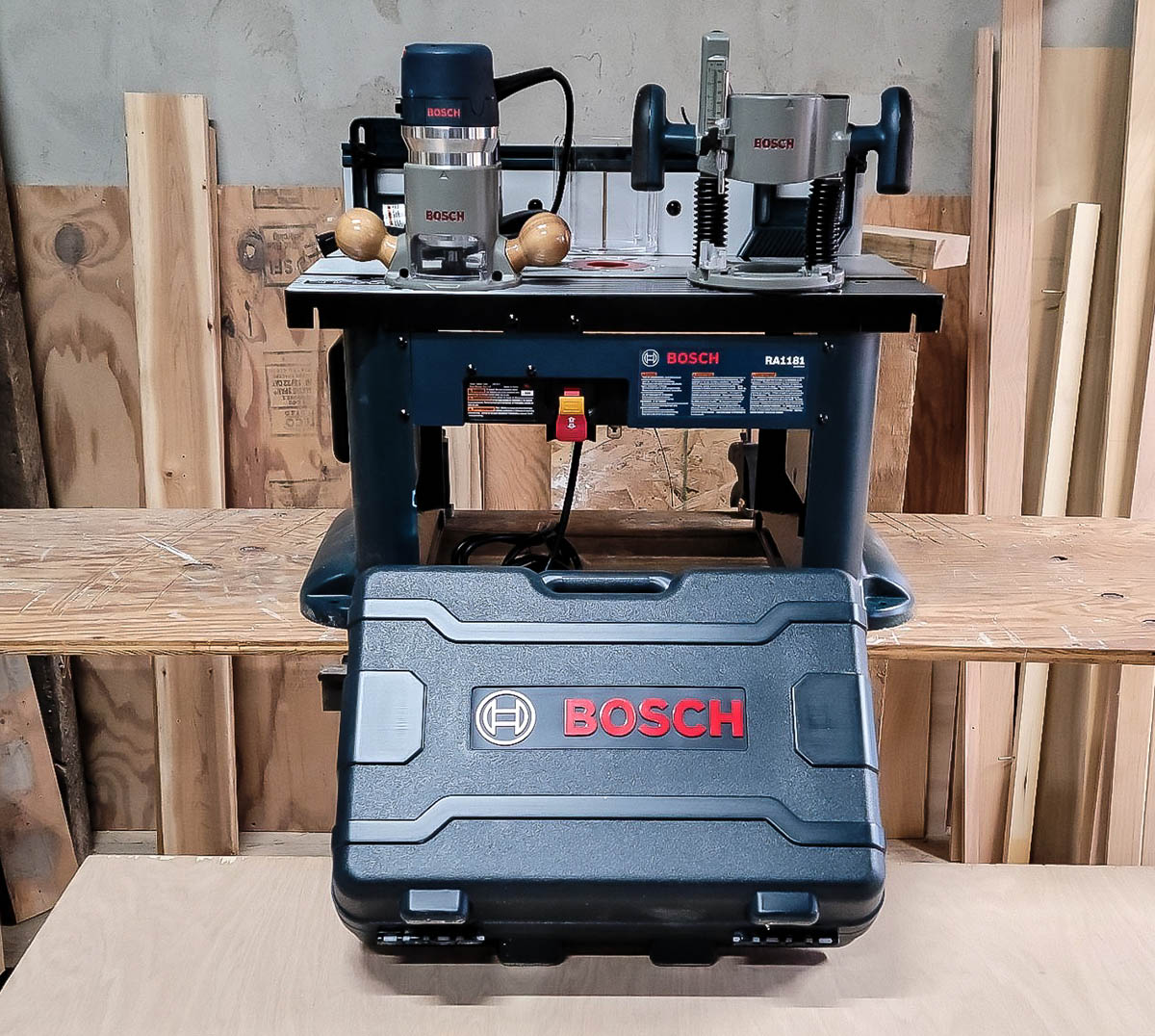
Those looking for a new router for woodworking projects have likely noticed a wide selection of styles. DIYers can choose between a fixed-base or plunge-style router, and some combo kits (with both options) are also available. Get to know the pros and cons of each type to choose the best one.
Fixed-Base
Fixed-base routers are the most basic models. They have a solid exterior casing, but users can adjust the depth of the router bit to create a variety of design options. They can adjust the bit’s depth by loosening the collar and twisting a dial. A fixed-base router is easy to set up and use on the outside edge of a board or countertop, but it can be challenging to start accurately in a workpiece’s field (middle). That’s because the router bit extends below the base plate, and the user has to tip the router carefully into position while the bit is spinning—which increases the odds of being slightly off the mark.
Plunge
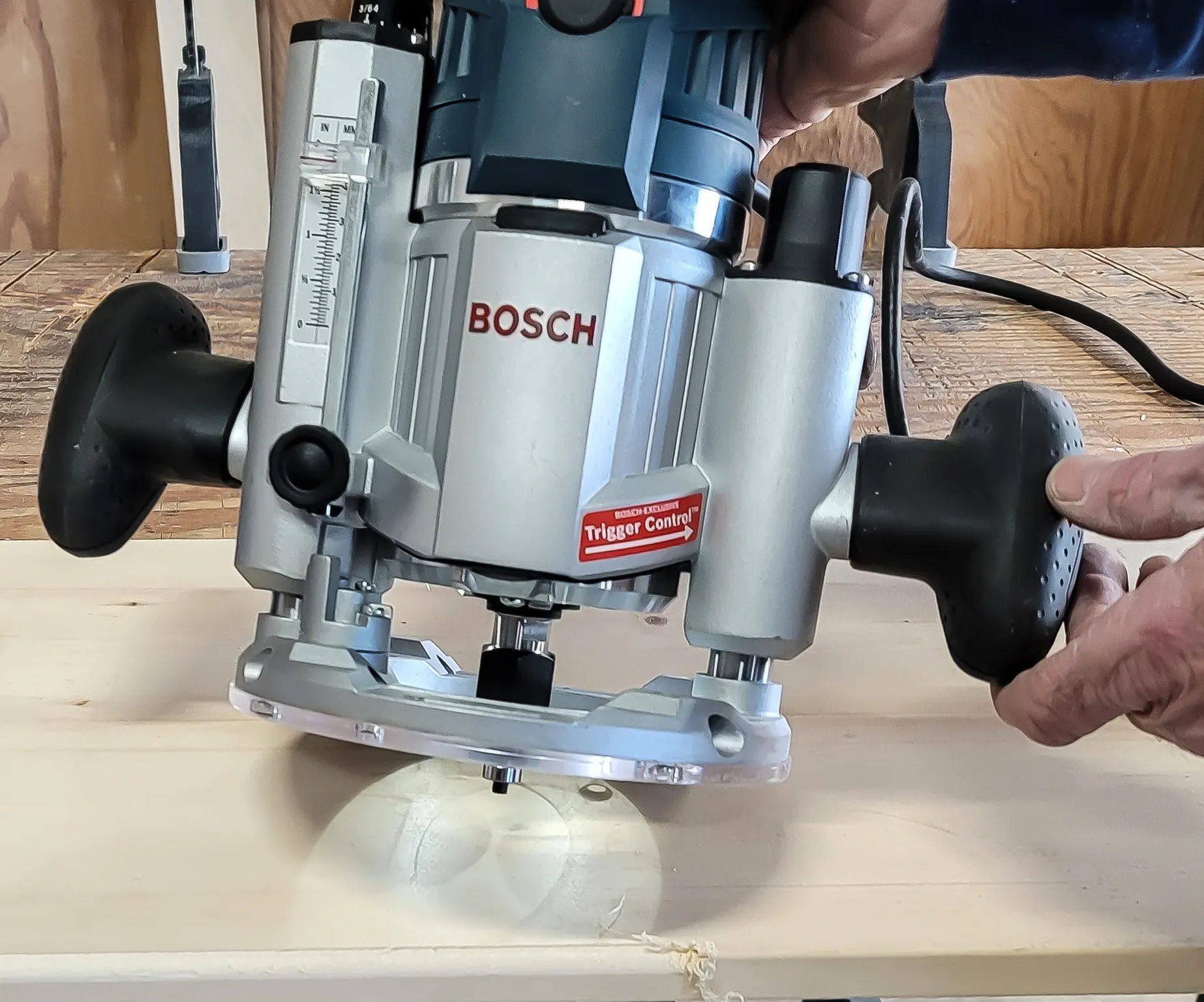
Plunge routers have a spring-loaded base that allows users to lower the spinning router bit into the field of a workpiece without the need to tip the router to the side. Like fixed-base routers, plunge routers come with depth gauges that let the user select the desired penetration of the cut. Plunge routers are the top pick for cutting details in the center of a board, but they’ll also work for edge profiling, making them versatile for both types of design cuts.
This type of router is a favorite of professional woodworker Richard Louise: “a plunge router is normally my go-to router (routers come with a fixed base or a plunge base). But the plunge version can do both, while the fixed base really can’t safely plunge.”
Combo
Alternatively, router packages are available that allow the user to swap exterior cases, providing fixed-base and plunge-base capabilities in the same kit. Though these combo kits are versatile and handy, they can be more expensive than a single router. Users don’t have to store two separate routers, but swapping bases frequently can slow the workflow.
Intended Use
When it comes to routers, intended use is a determining factor. If shoppers are looking for a good general-use router, they will want to stick with a fixed-base model. These models are easy to set, and users can build jigs (custom patterns) that allow for identical, repeated designs. A fixed-base router can be used on a router table for added stability. A fixed-base router’s primary use is to cut a shaped edge (called a “profile”) on boards and countertops.
Users who like to make mortise-and-tenon (interlocking) joints will want a plunge router since they’re more precise when making center-field cuts. The downside is that they’re not compatible with router tables.
Horsepower
The amount of power a router has helps determine how well it handles large router bits and dense hardwoods, such as ash or oak. While users can make multiple passes with any router—shaving off just a little at a time with each pass—a powerful router can shave off an entire edge design in one pass. When time is of the essence, a powerful router can make quick work of creating designs, but routing is usually more about precision than speed.
Most wood routers have horsepower ratings of 1.25 to 1.75, while some hot-rod versions have more than 2 hp. In most cases, the lower range works quite well, but 2-hp routers make short work of dense materials, such as hardwoods or Formica countertops.
For cordless models, power relates to battery size. Today’s rechargeable lithium-ion batteries are rated in amp hours and range from 1.5 up to 6Ah. The greater the amp hours, the more power the battery has. A battery with 3 to 5Ah hours is sufficient for most cordless routers.
Variable Speed
One of the challenging aspects of creating perfect edge profiles is choosing the correct speed to get the job done quickly without burning the wood. No magic speed exists, as boards (even among boards of the same species) differ in density. It comes down to experience and the right touch.
The good news is that a variable-speed router can be tweaked until users find just the right speed for a specific type of wood. They often have small dials to help select their speed. For a workable range, look for a router with speeds between 9,000 and 20,000 rpm.
Some routers have constant-speed sensors that monitor how quickly a bit is spinning and adjust it accordingly to maintain the ideal speed. For example, if woodworkers are using a router at 10,000 rpm but come across a particularly dense section of wood, the router can slow down and cause inconsistent results. With a constant-speed sensor, the router boosts its power output to compensate for the increase in density, so the bit continues to spin at the same speed.
Comfortable Grip
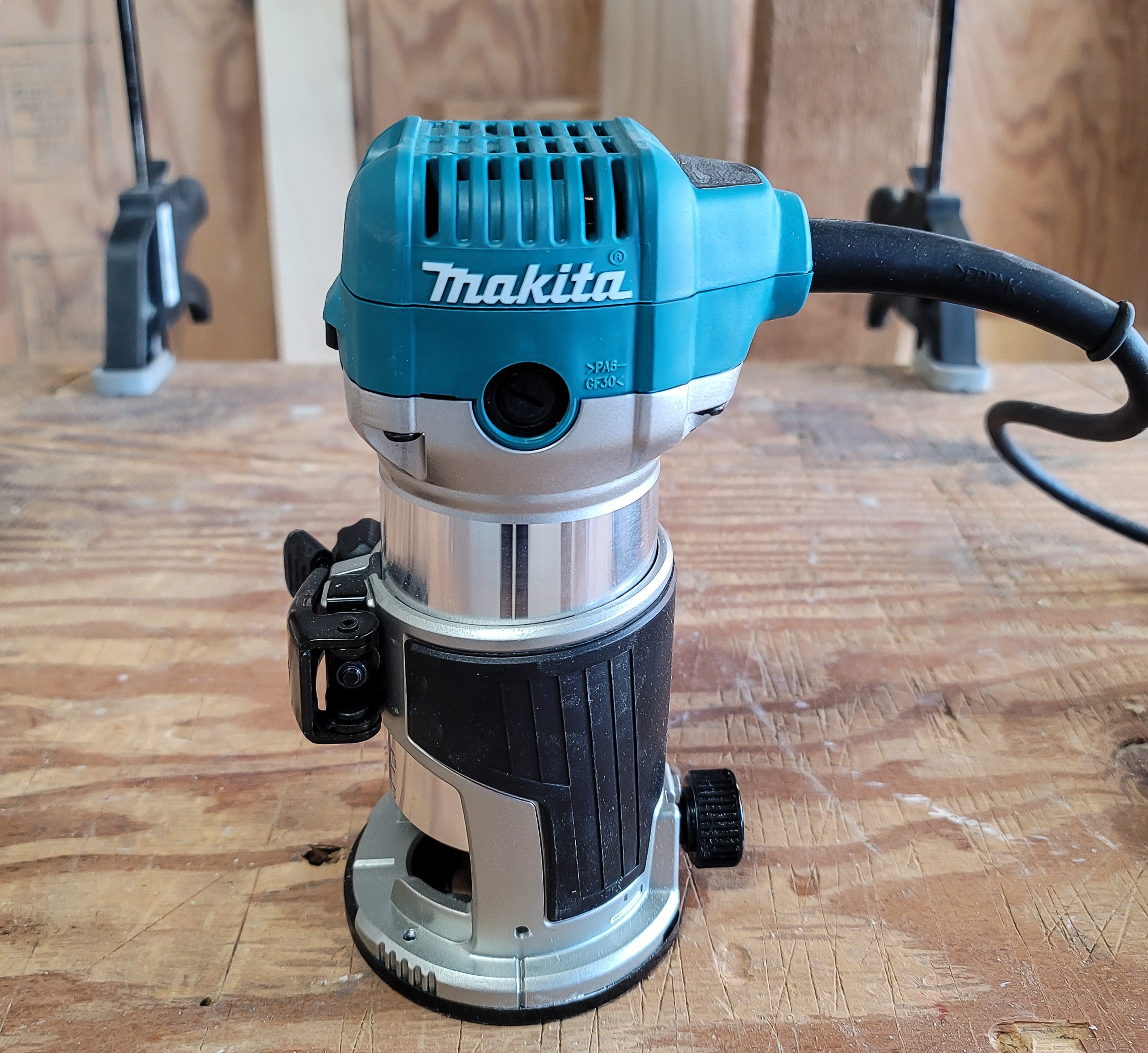
Routers are powerful tools, and users need a safe grip on them to ensure proper control. A comfortable grip helps users maintain a firm grasp.
Fixed-base routers and plunge routers often have two handles to provide better control. Depending on the manufacturer, they can be rubberized or made from polished wood. Some models even have handle-mounted switches, making it easy to turn the tools on and off without releasing a handle.
Palm routers fit in a single hand, so the body essentially becomes the handle. Many have rubberized moldings and contours meant for comfortable use.
Dust Collection Port
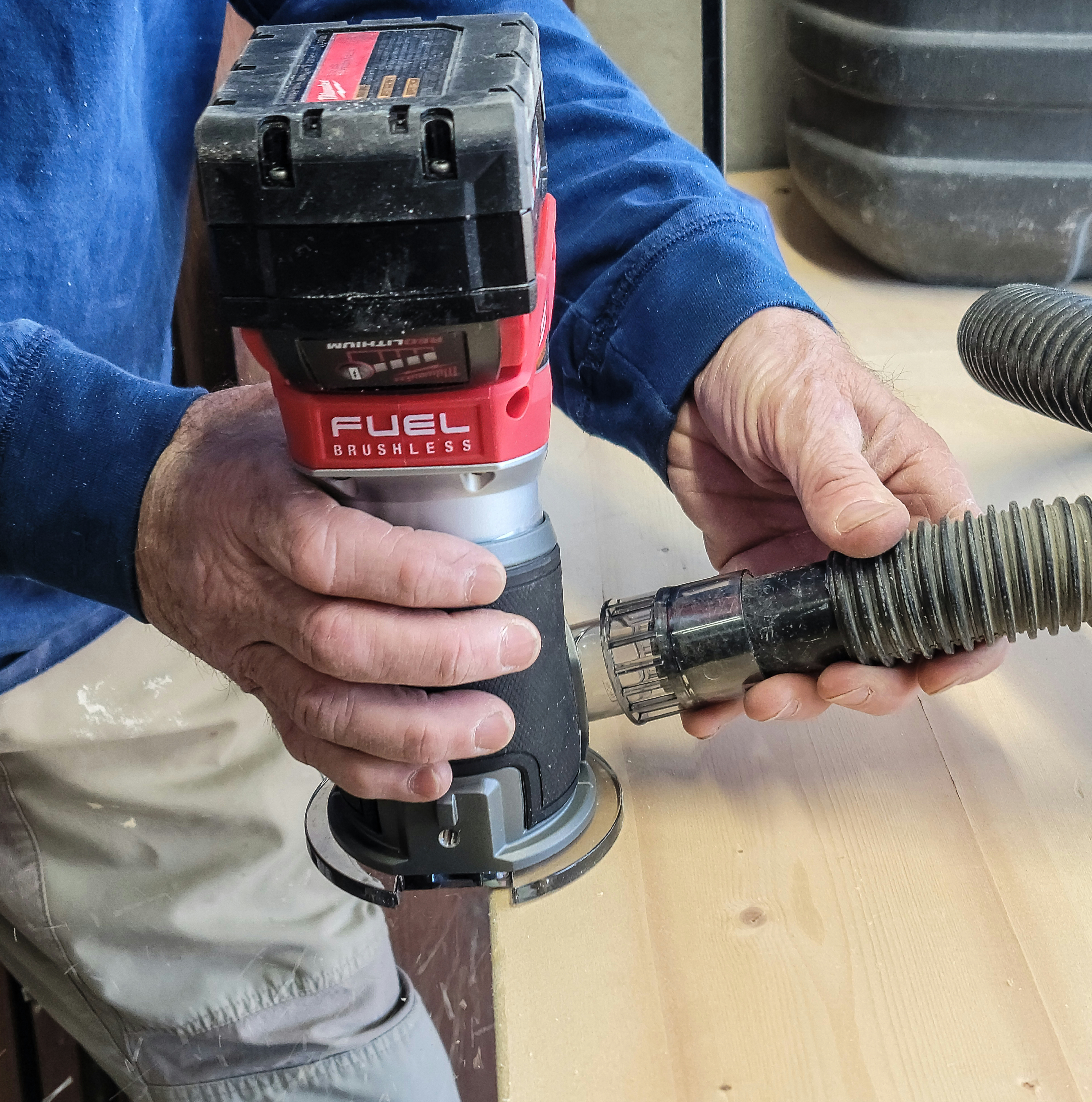
Routers make a lot of dust. The high-speed cutting/shaving process removes tiny bits of wood and sends them flying through the air, creating a mess and a potential breathing hazard. To avoid a lengthy cleanup, look for a router with a dust collection port that attaches to a shop vac or dust collection system.
Some router’s dust collection ports work better than others; higher-end models usually work best. These brands are popular among pros who work in custom woodworking shops where effective dust collection is necessary.
Collet Size
The bit size a router accepts is contingent on the size of the router’s collet—the adjustable holder that secures the bit in place. Bits come in two standard sizes: ¼ inch and ½ inch. The smaller (¼-inch) bit works well for light-duty jobs like edge profiling and milling hinge mortises in doors. However, it might not work as well for heavy-duty work, such as routing dense hardwoods, which requires the larger ½-inch bit.
Some of today’s smallest palm routers come with a collet that only accepts ¼-inch router bits, but the majority of routers come with interchangeable collets that accept bits of both sizes.
FAQs
A plunge router is a wood router, so no real difference exists. However, there is a difference between a fixed-base router and a plunge router: The plunge router has a spring-loaded base that allows you to lower the bit down safely into the center of a board. Doing so is significantly more difficult with a fixed-base router, as it requires tipping the router into position, which can reduce precision.
A fixed-base router works for most projects. If creating intricate joinery, however, look for a plunge-base router or use a fixed-base router with a table for added precision and stability.
It depends on the project. Light-duty routing with a ¼-inch collet router is absolutely fine, while heavy-duty work requires a ½-inch collet.
Torque (spinning power) matters much less than rpm. Your router needs speed (rpm) to work effectively, and adjustable (and maintainable) speed matters more than start-up power (torque). In fact, routers with too much torque can be downright dangerous, so manufacturers are less likely to use motors with too much torque.
Meet the Tester
Glenda Taylor is a product tester and writer specializing in the construction, remodeling, and real estate industries. She and her husband own a general contracting company, and Taylor is experienced in both residential and commercial building applications. She tests a wide range of power tools as well as other home improvement, household, and lawn-and-garden products.

